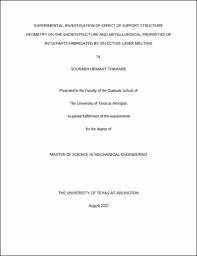
ATTENTION: The works hosted here are being migrated to a new repository that will consolidate resources, improve discoverability, and better show UTA's research impact on the global community. We will update authors as the migration progresses. Please see MavMatrix for more information.
Show simple item record
| dc.contributor.advisor | Ameri, Amir | |
| dc.creator | Thakare, Sourabh Hemant | |
| dc.date.accessioned | 2020-09-10T18:05:51Z | |
| dc.date.available | 2020-09-10T18:05:51Z | |
| dc.date.created | 2020-08 | |
| dc.date.issued | 2020-08-10 | |
| dc.date.submitted | August 2020 | |
| dc.identifier.uri | http://hdl.handle.net/10106/29435 | |
| dc.description.abstract | Additive Manufacturing is a modern manufacturing technique that provides extreme design freedom and the ability to manufacture multiple parts with high complexities at the same time. Various fabrication techniques have been developed, and this study focuses on selective laser melting (SLM) due to its ability to provide near-perfect parts at low cost while being able to work with a wide range of materials. In SLM, the part is manufactured, layer-by-layer, by melting and solidification of powder material under controlled inert conditions.
The fabrication of complex geometries is not possible without proper allocation of support structures for the part, which keeps the component intact and retains structural stability while manufacturing. The main function of the support structure is to complement the fabrication of the main part and reduce the chances of abnormalities in the structures or complete failure of the fabrication process. Supports are attached to the part and are to be removed after fabrication in such a way that the required surface finish is not compromised. Multiple properties like microstructural composition, residual stresses, mechanical properties, hardness, and toughness of SLM parts are either directly or indirectly affected by the allocation of a specific type of a support geometry. The challenge is to identify and allocate appropriate support structures after analyzing the part and the part orientation while ameliorating the functionality of removability, reducing material consumption, and enhancing structural support.
IN718 is a type of high-strength corrosion-resistant super alloy, which consists of nickel and chromium. It can withstand extremely high pressure and heat, which makes it suitable for high-end applications such as aerospace and petroleum. Due to the high toughness of the superalloy along with its work hardening, the difficulty in machinability of IN718 is immense, and thus the adaptation of additive manufacturing, specifically SLM, comes into consideration.
This study focuses on the effect of support structure geometry on the surface topography along with composition, hardness, melt-pool size, and grain structure for IN718 parts after the fabrication and removal of multiple iterations of support structures. A comprehensive report on the effect of support structure design is provided after studying the fundamental parameters of design, fabrication, testing, and results interpretation for the IN718 parts. | |
| dc.format.mimetype | application/pdf | |
| dc.language.iso | en_US | |
| dc.subject | Additive manufacturing | |
| dc.subject | Selective laser melting | |
| dc.subject | SLM | |
| dc.subject | Inconel 718 | |
| dc.subject | Support structures | |
| dc.title | Experimental investigation of effect of support structure geometry on the microstructure and metallurgical properties of IN718 parts fabricated by selective laser melting | |
| dc.type | Thesis | |
| dc.degree.department | Mechanical and Aerospace Engineering | |
| dc.degree.name | Master of Science in Mechanical Engineering | |
| dc.date.updated | 2020-09-10T18:05:51Z | |
| thesis.degree.department | Mechanical and Aerospace Engineering | |
| thesis.degree.grantor | The University of Texas at Arlington | |
| thesis.degree.level | Masters | |
| thesis.degree.name | Master of Science in Mechanical Engineering | |
| dc.type.material | text | |
| dc.creator.orcid | 0000-0002-0324-0064 | |
Files in this item
- Name:
- THAKARE-THESIS-2020.pdf
- Size:
- 4.601Mb
- Format:
- PDF
This item appears in the following Collection(s)
Show simple item record


